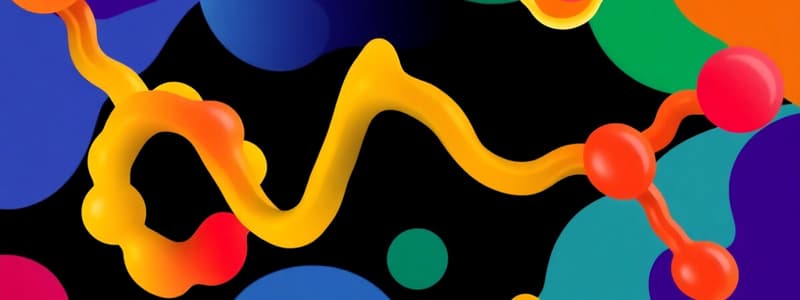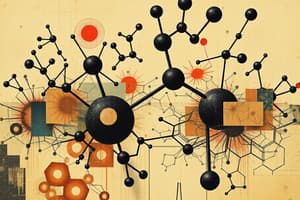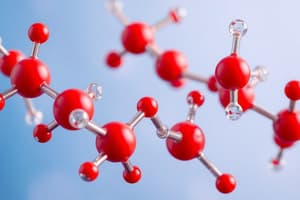Podcast
Questions and Answers
Which level of structural organization involves groups of similar cells working together?
Which level of structural organization involves groups of similar cells working together?
- Chemical Level
- Cellular Level
- Organ Level
- Tissue Level (correct)
Which organ system is responsible for controlling body responses?
Which organ system is responsible for controlling body responses?
- Skeletal System
- Muscular System
- Endocrine System
- Nervous System (correct)
Which of the following is NOT a component of the homeostatic system?
Which of the following is NOT a component of the homeostatic system?
- Stimulus (correct)
- Control Center
- Effector
- Receptor
Which of the following is an example of a negative feedback mechanism?
Which of the following is an example of a negative feedback mechanism?
What is the primary function of the integumentary system?
What is the primary function of the integumentary system?
Which organ system is responsible for filtering blood and removing waste?
Which organ system is responsible for filtering blood and removing waste?
What is the relationship between anatomy and physiology?
What is the relationship between anatomy and physiology?
Which of the following is a characteristic of anatomical position?
Which of the following is a characteristic of anatomical position?
Which anatomical plane divides the body into equal left and right halves?
Which anatomical plane divides the body into equal left and right halves?
Which of the following is NOT a directional term?
Which of the following is NOT a directional term?
Which of the following organs is NOT found in the abdominopelvic cavity?
Which of the following organs is NOT found in the abdominopelvic cavity?
Which layer of the serous membrane lines the cavity?
Which layer of the serous membrane lines the cavity?
A patient complains of pain in their right lower quadrant. Which of the following organs could be causing this pain?
A patient complains of pain in their right lower quadrant. Which of the following organs could be causing this pain?
Which of the following describes an anatomical position?
Which of the following describes an anatomical position?
What is the main function of serous membranes?
What is the main function of serous membranes?
Where is the spinal cord located?
Where is the spinal cord located?
What is the term used to describe a structure that is farther from the body's trunk?
What is the term used to describe a structure that is farther from the body's trunk?
Which of the following is NOT found in the Axial Region?
Which of the following is NOT found in the Axial Region?
Which of the following statements accurately describes the relationship between anatomy and physiology?
Which of the following statements accurately describes the relationship between anatomy and physiology?
Which of the following is NOT a characteristic of negative feedback?
Which of the following is NOT a characteristic of negative feedback?
Which of the following would be considered a superficial structure?
Which of the following would be considered a superficial structure?
Which serous membrane surrounds the lungs?
Which serous membrane surrounds the lungs?
What is the term used to describe a structure that is closer to the body's midline?
What is the term used to describe a structure that is closer to the body's midline?
Which of the following is an example of a positive feedback loop?
Which of the following is an example of a positive feedback loop?
Which of these elements forms the backbone of organic molecules?
Which of these elements forms the backbone of organic molecules?
Elements in the furthest left column of the periodic table have how many valence electrons?
Elements in the furthest left column of the periodic table have how many valence electrons?
Elements in the furthest right column of the periodic table, excluding helium, have how many valence electrons?
Elements in the furthest right column of the periodic table, excluding helium, have how many valence electrons?
As guided by the octet rule, atoms achieve stability by gaining, losing, or sharing which subatomic particle?
As guided by the octet rule, atoms achieve stability by gaining, losing, or sharing which subatomic particle?
Which of the following is NOT a characteristic of lipids?
Which of the following is NOT a characteristic of lipids?
Which term best describes a molecule that has both a hydrophilic (water-attracting) and a hydrophobic (water-repelling) end?
Which term best describes a molecule that has both a hydrophilic (water-attracting) and a hydrophobic (water-repelling) end?
What type of substance will neutralize a solution of hydrochloric acid (HCl)?
What type of substance will neutralize a solution of hydrochloric acid (HCl)?
What must neutralize the stomach acid that enters the small intestine, and how does it affect the pH?
What must neutralize the stomach acid that enters the small intestine, and how does it affect the pH?
Table sugar completely dissolved in water is an example of which type of mixture?
Table sugar completely dissolved in water is an example of which type of mixture?
Which of the following is an organic molecule?
Which of the following is an organic molecule?
Which of the following is a characteristic of both organic and inorganic compounds?
Which of the following is a characteristic of both organic and inorganic compounds?
Which of the following is NOT a characteristic of a solution?
Which of the following is NOT a characteristic of a solution?
Which type of molecule has a polar end and a nonpolar end?
Which type of molecule has a polar end and a nonpolar end?
Which type of chemical bond involves the sharing of electrons between atoms?
Which type of chemical bond involves the sharing of electrons between atoms?
Which of the following is a characteristic of a covalent bond?
Which of the following is a characteristic of a covalent bond?
Which of the following is an example of a macromolecule?
Which of the following is an example of a macromolecule?
Which type of molecule is responsible for carrying genetic information?
Which type of molecule is responsible for carrying genetic information?
Which component of a homeostatic system is responsible for detecting changes?
Which component of a homeostatic system is responsible for detecting changes?
What is the primary role of negative feedback in homeostasis?
What is the primary role of negative feedback in homeostasis?
Which plane of the body divides it into equal left and right halves?
Which plane of the body divides it into equal left and right halves?
What type of feedback mechanism would be involved in the process of childbirth?
What type of feedback mechanism would be involved in the process of childbirth?
Which abdominal quadrant contains the stomach and spleen?
Which abdominal quadrant contains the stomach and spleen?
Which of the following is NOT one of the major body cavities?
Which of the following is NOT one of the major body cavities?
What buffer system is primarily responsible for maintaining blood pH?
What buffer system is primarily responsible for maintaining blood pH?
Which directional term refers to a position above another structure?
Which directional term refers to a position above another structure?
Which structure is responsible for restoring balance in a homeostatic system?
Which structure is responsible for restoring balance in a homeostatic system?
Which of the following substances does NOT contain carbon-hydrogen bonds?
Which of the following substances does NOT contain carbon-hydrogen bonds?
What do cations and anions represent?
What do cations and anions represent?
Which of these accurately describes the Octet Rule?
Which of these accurately describes the Octet Rule?
What is the characteristic of polar covalent bonds?
What is the characteristic of polar covalent bonds?
Which pH value indicates a neutral solution?
Which pH value indicates a neutral solution?
What does a base do when added to an acidic solution?
What does a base do when added to an acidic solution?
What is the main function of proteins in biological systems?
What is the main function of proteins in biological systems?
Which of the following substances is categorized as a biological macromolecule?
Which of the following substances is categorized as a biological macromolecule?
What type of bond links nucleotides in DNA?
What type of bond links nucleotides in DNA?
What is a characteristic feature of water due to hydrogen bonding?
What is a characteristic feature of water due to hydrogen bonding?
Which of the following describes negative feedback in biological systems?
Which of the following describes negative feedback in biological systems?
Which property of water allows it to transport substances efficiently in the body?
Which property of water allows it to transport substances efficiently in the body?
What is the role of buffers in biological systems?
What is the role of buffers in biological systems?
Flashcards
Anatomy
Anatomy
The study of structure and relationships between body parts.
Physiology
Physiology
The study of function of body structures and how they work together.
Structure dictates function
Structure dictates function
The shape and organization of body parts determine how they work.
Levels of Structural Organization
Levels of Structural Organization
Signup and view all the flashcards
Integumentary System
Integumentary System
Signup and view all the flashcards
Negative Feedback
Negative Feedback
Signup and view all the flashcards
Positive Feedback
Positive Feedback
Signup and view all the flashcards
Homeostasis
Homeostasis
Signup and view all the flashcards
Transverse Plane
Transverse Plane
Signup and view all the flashcards
Coronal Plane
Coronal Plane
Signup and view all the flashcards
Midsagittal Plane
Midsagittal Plane
Signup and view all the flashcards
Superior
Superior
Signup and view all the flashcards
Inferior
Inferior
Signup and view all the flashcards
Ventral (Anterior)
Ventral (Anterior)
Signup and view all the flashcards
Dorsal (Posterior)
Dorsal (Posterior)
Signup and view all the flashcards
Proximal
Proximal
Signup and view all the flashcards
Distal
Distal
Signup and view all the flashcards
Axial Region
Axial Region
Signup and view all the flashcards
Appendicular Region
Appendicular Region
Signup and view all the flashcards
Dorsal Cavity
Dorsal Cavity
Signup and view all the flashcards
Ventral Cavity
Ventral Cavity
Signup and view all the flashcards
Serous Membranes
Serous Membranes
Signup and view all the flashcards
Visceral Pericardium
Visceral Pericardium
Signup and view all the flashcards
Subatomic Particles
Subatomic Particles
Signup and view all the flashcards
Common Elements in Human Body
Common Elements in Human Body
Signup and view all the flashcards
Valence Electrons in Group 1
Valence Electrons in Group 1
Signup and view all the flashcards
Valence Electrons in Group 18
Valence Electrons in Group 18
Signup and view all the flashcards
Octet Rule
Octet Rule
Signup and view all the flashcards
Ionic Bonds
Ionic Bonds
Signup and view all the flashcards
Covalent Bonds
Covalent Bonds
Signup and view all the flashcards
Hydrogen Bonds
Hydrogen Bonds
Signup and view all the flashcards
Cations
Cations
Signup and view all the flashcards
Anions
Anions
Signup and view all the flashcards
pH Scale
pH Scale
Signup and view all the flashcards
Properties of Water
Properties of Water
Signup and view all the flashcards
Biological Macromolecules
Biological Macromolecules
Signup and view all the flashcards
Phosphodiester Bonds
Phosphodiester Bonds
Signup and view all the flashcards
Carbon
Carbon
Signup and view all the flashcards
Noble Gases
Noble Gases
Signup and view all the flashcards
Lipids
Lipids
Signup and view all the flashcards
Amphipathic Molecules
Amphipathic Molecules
Signup and view all the flashcards
Neutralization
Neutralization
Signup and view all the flashcards
Stomach Acid Neutralization
Stomach Acid Neutralization
Signup and view all the flashcards
Solution
Solution
Signup and view all the flashcards
Organic Molecule
Organic Molecule
Signup and view all the flashcards
Polar and Nonpolar
Polar and Nonpolar
Signup and view all the flashcards
Reactivity of Elements
Reactivity of Elements
Signup and view all the flashcards
Chemical Bonds
Chemical Bonds
Signup and view all the flashcards
Acidic Solution
Acidic Solution
Signup and view all the flashcards
Components of Homeostasis
Components of Homeostasis
Signup and view all the flashcards
Body Planes
Body Planes
Signup and view all the flashcards
Directional Terms
Directional Terms
Signup and view all the flashcards
Major Body Cavities
Major Body Cavities
Signup and view all the flashcards
Abdominopelvic Quadrants
Abdominopelvic Quadrants
Signup and view all the flashcards
Monomer
Monomer
Signup and view all the flashcards
Polymer
Polymer
Signup and view all the flashcards
Study Notes
Monomers and Polymers
- Monomer: A small, basic molecular unit capable of bonding with similar units through covalent bonds to form a larger molecule called a polymer
- Polymer: A large molecule comprised of repeating smaller monomer units linked together by covalent bonds.
- Dehydration Synthesis: The process where monomers bond together by removing a water molecule.
- Hydrolysis: The process where polymers are broken down by adding a water molecule to break the bonds between monomers.
- Biological Macromolecules: Large molecules essential for life, including carbohydrates, proteins, nucleic acids, and lipids.
Examples of Monomers and Polymers
| Monomer | Polymer | Example & Function |
|---|---|---|
| Monosaccharides (e.g., glucose) | Carbohydrates | Energy storage (e.g., glycogen, starch) |
| Amino acids | Proteins | Enzymes, structural support, muscle function |
| Nucleotides | Nucleic Acids (DNA/RNA) | Store & transfer genetic information |
| Fatty acids & Glycerol | Lipids (e.g., triglycerides, phospholipids) | Energy storage, cell membranes |
Studying That Suits You
Use AI to generate personalized quizzes and flashcards to suit your learning preferences.



